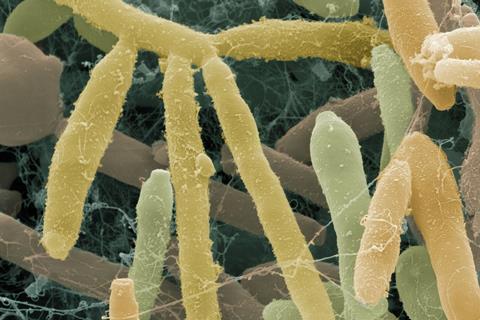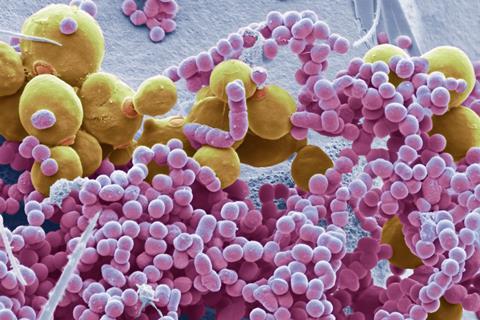
Tuck into the chemistry of fermentation to discover whether the gut- and brain-boosting claims are sugarcoated
From sauerkraut to kefir, fermented foods are widely touted as gut-enriching, health-boosting products. Researchers are delving into the chemical detail of fermented foods, in a bid to understand their potential health effects.
Humans began fermenting foods thousands of years ago, mainly to prolong their shelf life. Popular types of fermented foods vary by region, from European fermented dairy products like cheese and yoghurt, to East Asian fermented soy products such as miso and soy sauce.
Today, specialised fermented foods come with a host of health claims including more diverse gut bacteria, lower levels of inflammation in the body and cardiovascular protection. Yet it’s difficult to pick out which of the many substances in a fermented food – from plant-based chemicals to live microbes and their metabolites – may actually provide positive health effects.
In your class
Fermentation is an important process used in cooking, baking and drink-making around the world. We can also use the alcohol produced as a fuel. Use these applications to provide context to learners when teaching about alcohols, carbohydrates and enzymes and make cross-curriculum links to biology.
The basics
There are four main fermentation processes: lactic, acetic, alcoholic and alkaline. Lactic acid bacteria (LAB) – including lactobacillus and streptococcus – are key for dairy, meat and vegetable products. Meanwhile, acetic acid bacteria such as gluconacetobacter are used to ferment vinegar and the sugary tea known as kombucha.

Kefir is one of the most popular and well-studied fermented products. It can be made from sugared water or milk, using a starter culture containing yeasts as well as LAB and acetic acid bacteria. LAB also play a pivotal role in producing fermented cabbage, known as sauerkraut. As a result, the final product contains high levels of a carboxylic acid ion called lactate, the conjugate base of lactic acid.
Yeasts drive alcoholic fermentations to produce beer, wine and breads, while fungi such as aspergillus provide alkaline fermentations for some cheeses, fermented meats and soy products. In all types of fermentation, microbial enzymes break down substances in the raw food to produce metabolites, such as amino acids, peptides and fatty acids. These can add flavour and may have bioactive properties.
While today’s DNA sequencing technology makes it possible to identify all the microbes in a fermented food or the human gut, demonstrating a health benefit and directly associating it with a change in the gut microbiome remains difficult, according to fermentation expert Tom Beresford, a research officer at Teagasc, the Irish Agriculture and Food Development Authority. The necessary human trials are costly and take a relatively long time to complete.
Human trials also have limitations because they generally require participants not only to take personal responsibility for eating fermented products but also to quantify and report their consumption. Nevertheless, these studies can help to gain a broad picture of potential health effects.
Microbial metabolites
In 2021, a team from Stanford University, US, found a ‘stark difference’ between the effects of two diets on gut microbe diversity. The team studied 36 healthy adults who were randomly assigned a diet with extra servings of either fermented products or high-fibre foods. Foods such as kefir, kimchi and kombucha tea increased overall microbial diversity and decreased levels of inflammatory markers.
In particular, they found lower activity for four types of immune cells in the fermented food group as well as decreased levels of 19 inflammatory proteins in blood samples. One of these proteins, called interleukin-1, has been linked to conditions such as rheumatoid arthritis, type 2 diabetes and chronic stress.
People on a ‘psychobiotic’ diet rich in fruits, vegetables and fermented foods reported lower stress levels and improved sleep
Despite signs of biological effects, it is still unclear exactly how live microbes and chemical metabolites interact with the microbes living in the body – the microbiome. ‘While this is an open area of investigation, mechanistic studies have pointed to metabolites as the key mediators between microbe-host and microbe-microbe interactions, functioning as sources of energy, building material and signalling molecules,’ explains Elisa Benedetti Caffrey, a PhD candidate at Stanford.

‘More work is still needed to understand exactly which metabolites are produced during fermentation, as well as their concentrations and bioavailability,’ she says. It’s also important to look at how different food production systems affect the microbial production of metabolites, she adds. For example, Elisa is interested in how concentrations of acetic acid in kombucha change in the time between bottling and consumption.
The researchers found that lactate alone or bacterial metabolites in sterilised brine significantly altered the intestinal population of microbes in a different way to the unsterilised sauerkraut brine. They fed the same products to germ-free mice colonised with human faecal bacteria to make them ‘humanised’. In these mice, the fermented food appeared to have the biggest impact in the small intestine, with effects largely independent of live microbes.
The study concluded that microbial metabolites alone have the capacity to alter people’s microbial populations. The authors suggest that lactate is a ‘keystone metabolite’ that ‘restructures intestinal microbiota composition and alters host immunity’. The Stanford team suggests that people may benefit from a daily intake of bacterial metabolites, especially lactate.
Gut–brain axis
At University College Cork (UCC) and Teagasc Food Research Centre, Ireland, researchers are looking in detail at microbial metabolites, with a particular interest in how the gut and the brain communicate with each other, through the so-called gut–brain axis. Short-chain fatty acids (SCFAs), such as acetic acid, propionic acid and butyric acid, as well as tryptophan metabolites, which form in the gut, are thought to play a role in this communication.

‘We know so much in terms of overall profile – what a human study will tell you is what it means for the end user. But what does it mean mechanistically?’ asks Ramya Balasubramanian a PhD candidate at Teagasc and APC Microbiome, a research centre hosted by UCC. Running tests on mice helps to ‘tease apart theories as to what is really going on,’ she says.
Ramya is part of a team running rafts of tests on fermented foods and metabolites, including studies on mice. The researchers have looked at over 200 foods from around the world, looking for metabolites known to be beneficial to brain health. When they analysed the foods using computational models, they were surprised to find that almost all have the ‘potential’ to improve gut and brain health, based on their predicted metabolites.
This helped them to narrow down which of the foods to focus on, selecting a group of 10 different fermented products. They are using an in vitro (simulated) model of a colon to see how the foods might affect the gut microbiome. ‘We have certain metabolites that we are really interested in, such as tryptophan metabolites and glutamate,’ says Ramya. The results from the colonic simulation will guide which foods to study in mice.
Ramya is particularly interested in finding out which variables play a role in health effects and how much difference fermentation makes. She gives the example of kombucha, which is packed with healthy polyphenols found in tea. ‘The rational question would be: can you get the same benefits if you just drink tea,’ she says. She is running separate tests on a range of kombucha items, from sterilised kombucha to a filtered product, where the microbes have been removed but the metabolites remain.

The team can feed different products to rodents, monitoring overall gut health as well as running behavioural studies, for example seeing how they react to stress. ‘Can we pick out certain pathways that are upregulated? It’s really a shot in the dark. Our first question is if the process of fermentation is of any benefit,’ Ramya adds.
Another example is sauerkraut, made by fermenting cabbage. Both raw and fermented cabbage are high in fibre, which is good for the gut. They also both contain isothiocyanates, which are thought to have beneficial health effects as antioxidants. ‘You really want to know if the process of fermentation is that additional special sauce that can help in boosting the bioactive, neuroactive and psychobiotic profile,’ Ramya explains.
So, does fermentation boost the health effects of certain foods and beverages? The studies look promising, but consuming fermented food won’t be a quick fix and should become a lifelong habit, Ramya advises.
